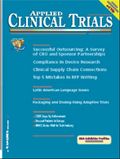Clinical Research Under Scrutiny
Applied Clinical Trials
Agency officials and sponsors anticipate stiffer oversight of research operations and disclosure requirements.
The Food and Drug Administration is stepping up oversight and enforcement activity for medical products, including the conduct of clinical trials. There are more warning letters going to investigators, and institutional review boards (IRBs) are under scrutiny following the recent exposé of lax reviews. Sponsors feel pressure to monitor studies more carefully and to fully disclose clinical trial activity and study results in public databases.

Jill Wechsler
"Enforcement will increase," warned Deborah Autor, director of the Office of Compliance in FDA's Center for Drug Evaluation and Research (CDER), at the April annual meeting of the Food and Drug Law Institute (FDLI). She pointed to a rise in injunctions, investigator disqualifications, and warning letters and advised companies to avoid the big stick by "being proactive about compliance."
This emphasis reflects the attitude of FDA's new leadership. Principal deputy commissioner Joshua Sharfstein, who was acting commissioner until Margaret (Peggy) Hamburg was confirmed to the top spot in May, made it clear that a new sheriff is in town. Soon after coming to FDA in March, Sharfstein initiated a fast and more aggressive recall of pistachio products at the first sign of salmonella contamination. He also responded to criticism of FDA's process for regulating medical devices by supporting a review of research requirements for device classes.
The global swine flu outbreak provided another opportunity for FDA to take a more proactive approach. Sharfstein authorized emergency access to antiviral drugs and diagnostics and established teams under Jesse Goodman, newly named deputy commissioner for scientific and medical programs and acting chief medical officer, to facilitate development of new vaccines, antivirals, diagnostics, and additional policies needed to combat a pandemic.
As former director of FDA's Center for Biologics Evaluation and Research (CBER), Goodman has been active in vaccine development and global health issues. In addition to heading up FDA response to the flu outbreak, Goodman will oversee FDA's National Center for Testing and Research in Arkansas and several agency-wide public health and science programs, including pediatric therapeutics, combination products, women's health, critical path programs, good clinical practices, and the sentinel safety initiative. A number of hot topics fill Goodman's plate: comparative effectiveness research, biomarker identification, clinical trial design, and personalized medicine.
Building on FDAAA
Congressional leaders also support a more aggressive FDA. The Senate Health, Education, Labor and Pensions (HELP) Committee moved quickly last month to facilitate Hamburg's confirmation as FDA commissioner, stressing the need for a strong agency to deal with the swine flu outbreak, as well as food and drug safety issues.
Several legislative proposals before Congress would further enhance enforcement powers already bolstered by the FDA Amendments Act (FDAAA) of 2007, which increased fines and criminal penalties for violative activities. So far, FDA has not brought a case under these new authorities, Autor said, "but when we need to use it, we will."
Autor's staff has grown to 250 from 150 five years ago, which increases its ability to take regulatory action; CDER had issued almost 40 warning letters as of April 14, 2009, nearly half of the 87 sent out in all of 2008. These include more warnings to clinical investigators for violating good clinical research practices and a jump in investigator disqualification actions. The trend raises questions about the quality of oversight by sponsors and contract research organizations, Autor said. She also emphasized the importance of data integrity, citing the need for due diligence by companies involved in corporate mergers and acquisitions to verify the quality of submissions to FDA.
An example of more "swift, aggressive action" in enforcement cases, said Autor, is how quickly it issued a warning letter toCoastIRB following revelations that Coast had approved a fictitious study presented in a sting operation by the Government Accountability Office. Only a few weeks after the malfeasance was revealed at a heated hearing on Capitol Hill, FDA instructed Coast to halt oversight of some 300 active trials and to cease operations until it remedies its problems. The case has focused attention on the quality of review provided by independent IRBs, and on FDA's capacity for auditing IRBs and other entities entrusted with oversight of human subject research.
More disclosure
Sponsors also face stiff penalties under FDAAA for failing to comply with requirements for posting clinical trial results on the clinicaltrials.gov database. The result has been a surge in trial listings in the system operated by the National Library of Medicine (NLM) at the National Institutes of Health (NIH); the database now has information on more than 71,000 studies, more than half involving drugs and biologics. Sponsors continue to object to posting full information on most Phase I trials, and generics firms oppose listing bioequivalence studies, but other contentious issues have been resolved.
The next big challenge is to clarify policies for posting the results of listed studies. Sponsors have been submitting results information since last fall, creating a database that now has some 700 records, more than 400 from industry sources. Submissions at this time consist of tables listing basic results, which includes demographic and baseline characteristics of participants and primary and secondary outcomes, in both cases for the full trial and for each study arm.
Reports on serious and frequent adverse events have to be added to the database beginning in September 2009. FDAAA calls for providing this data in a tabular format, but it's not obvious that the information is useful to patients or researchers. Sponsors seek clarity on what events are considered "serious" and on time frames for submitting AE reports; one hope is to gain more synergy in AE reporting requirements for NIH, FDA, and other entities.
A number of thorny policies remain to be worked out by September 2010, as discussed at an NIH public forum held in April to hear comments from industry and other stakeholders. Key issues are whether results must be filed for discontinued studies; if sponsor-written narrative summaries would be biased and promotional; and how to harmonize reporting standards with other countries.
Providing narrative summaries of results was the most contentious issue. Consumer advocates and medical journal editors objected that allowing sponsors to submit summaries of study results creates an opportunity for marketers to publicize not-yet-approved treatments. Consumers Union proposed that NIH staffers write up objective trial summaries, supported by an additional user fee on FDA applications. Pharma companies identified the International Conference on Harmonization E3 study synopsis as an internationally accepted format for technical summaries, but sought assurance that FDA will not charge companies with illegal promotional activity based on required results disclosure.
A related issue is whether providing summaries reduces the need to post full clinical trial protocols. Sponsors fear that full protocols may reveal proprietary information on how data will be assessed, and also raise privacy issues by disclosing the names of all investigators and subinvestigators. And pharma companies want leeway to determine which discontinued studies warrant reporting of results, limiting that primarily to studies dropped for safety reasons.
Industry moved to defuse some of the opposition by unveiling a revised version of the PhRMA (Pharmaceutical Research and Manufacturers of America) voluntary clinical trial disclosure policy, which now supports "timely registration of all interventional clinical trials involving patients." That still would leave out most Phase I safety studies, which enroll primarily healthy volunteers. PhRMA also would limit reporting on Phase IV trials to those that are interventional, as opposed to the vast spectrum of observational studies.
Avoiding conflicts
PhRMA also supports the authorship standards set by medical journal editors that permit only real contributors to a manuscript to be listed as authors and require disclosure of sponsor involvement with a study and relationships with authors. These fit the recommendations for avoiding conflicts of interest in biomedical research proposed in a high-profile report from the Institute of Medicine (IOM). An expert panel chaired by Bernard Lo, professor of medical ethics at the University of California San Francisco, advises against researchers claiming authorship of ghost-written publications or accepting any gifts, meals, drug samples or fees from industry.
The report backs full disclosure by physicians and researchers of all payments from pharma companies and other manufacturers and supports legislation requiring drugmakers to report all payments to health care providers, researchers, and health-related organizations. There are recommendations for curbing industry support of continuing medical education and efforts to remove industry influence from organizations developing clinical practice guidelines for practitioners—all proposals that fit well with the pro-regulatory stance of the new administration.
Jill Wechsler is the Washington editor of Applied Clinical Trials, (301) 656-4634 jwechsler@advanstar.com

FDA Fast Tracks Johnson & Johnson’s Nipocalimab for Fetal Neonatal Alloimmune Thrombocytopenia
March 27th 2024Johnson & Johnson is moving forward with a pair of Phase III trials of nipocalimab to reduce the risk of fetal neonatal alloimmune thrombocytopenia in alloimmunized pregnant patients.
Citius Pharmaceuticals Resubmits BLA to FDA for Lymphir to Treat Cutaneous T-Cell Lymphoma
March 19th 2024Pivotal Phase III Study 302 trial data show an objective response rate of 36.2% based on an independent review committee assessment in the treatment of relapsed/refractory cutaneous T-cell lymphoma.